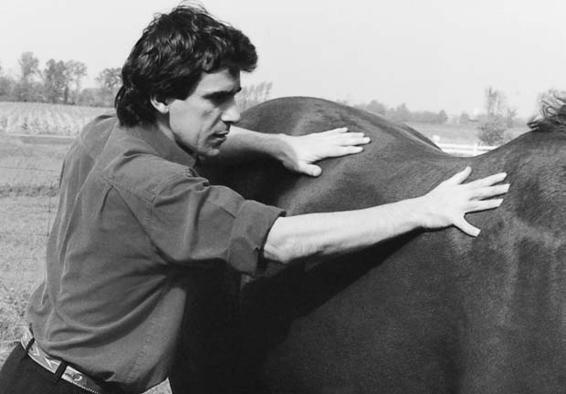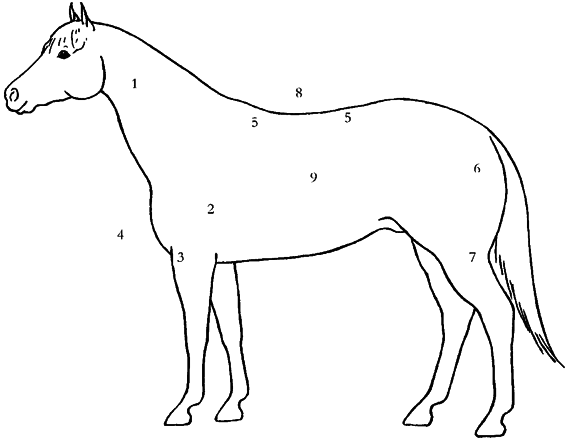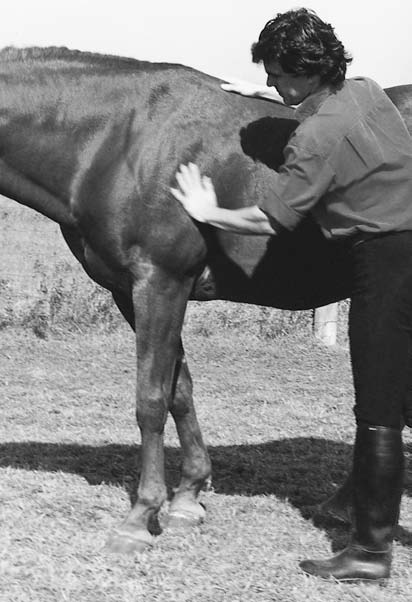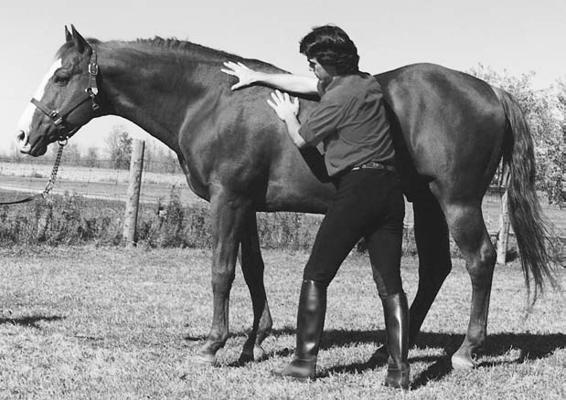Equine Massage: A Practical Guide (29 page)
Read Equine Massage: A Practical Guide Online
Authors: Jean-Pierre Hourdebaigt

Then move to the head and drain the area under the jaw (point 7; figure 6.30), along the throatlatch and the trachea, back toward the neck. To finish this routine and soothe the horse, use a lot of light strokings over the entire body from neck to tail and down the legs.
Remember that a horse showing stiffness and some lymphatic inflammation will be fairly sensitive. The sensory nerve endings are very tender and will therefore respond quickly to pressure. Be very gentle when you start this routine. Constantly check the feedback signs from the horse as you proceed. Pay close attention
6.31 Thorough Effleurage:
Going up the legs
(light to medium pressure), the recuperation
routine.

Massage Routines
147
6.32 Multiple Effleurages:
Light to medium pressure over the whole body,
the recuperation routine.
to what your fingers tell you (the four T’s, chapter 3).Your starting pressure should be about 1 or 2 pounds. Gently build to between 3 and 5 pounds if the horse appears comfortable.
The recuperation routine should last between 20 and 30 minutes, and is wrapped up by gently stroking the whole body.
The Warm-Up Routine
The warm-up routine is designed to stimulate circulation in a short period with the intention of perking up the horse before riding or exercising.The massage will bring more blood, oxygen, and nutrients to the muscle fibers. The routine is not a replacement for warm-up exercise, but is nonetheless a valuable start as you are grooming and about to saddle up.
For this routine, use mostly stimulating movements such as shakings, wringings, and tapotements, all interspersed with plenty of effleurages. Perform the routine briskly but not to the point of irritating the horse, at a rhythm of 2 to 3 strokes per second.Your pressure should vary from 5 to 8 pounds at the beginning or when going over bony areas, up to 10 and 20 pounds when going over large muscle groups. Start gently, progressively increasing the rhythm and pressure of your moves. Remember, the intent is not to spend time performing deep massage on specific muscles.

148
Equine Massage
Warm-Up Routine Outline
Connect with the animal for a few seconds by talking quietly and gently massaging the poll and the upper neck with light muscle squeezings.
Beginning on the left side of the neck (point 1; figure 6.33) with light shakings, use a gentle rhythm of 1 stroke per second, slowly increasing the pace to 2 or 3 strokes per second. Then switch to wringings, covering the whole neck all the way down to the left shoulder (point 2; figure 6.33) and upper leg.
Thoroughly cover all muscles. Intersperse with effleurages every 20 to 30 seconds and when moving from one body part to another.
Thoroughly massage the upper leg (point 3; figure 6.33), both on the inside and outside. Use shakings, wringings, picking ups, and large kneadings interspersed with effleurages. Drain toward the heart, starting from the upper leg and working down with every move. Once at the bottom of the leg, drain the entire leg with two long effleurage strokes from the fetlock to the shoulder.
Keep your pressure moderate (8 to 12 pounds) and your rhythm swift.
Next, massage the chest (point 4; figure 6.33) thoroughly with shakings, muscle squeezings, and kneadings, draining the area with
6.33 Warm-Up/Cool-Down Massage Routine

Massage Routines
149
effleurages every 20 or 30 seconds.Then go back over the shoulder with some effleurages or strokings, working your way to the withers (point 5; figure 6.33). From there, apply wringings across the entire back, 2 or 3 times, interspersed with effleurages.
Proceed to some tapotements, starting with clappings and then hackings, followed with effleurages. Then work the entire back and rib cage using shakings. Drain toward the heart with effleurages every 20 seconds as you progress. Watch for feedback signs from the horse.You should slow down the pace as you reach the groin area, since it is very sensitive and horses are very protective of it.
Next, go over the large muscle group of the hindquarters (point 6; figure 6.33) and down to the stifle and hock, using shakings, wringings, large palmar kneadings, and compressions, all interspersed with effleurages every 20 or 30 seconds. Work the
6.34 Fine Shaking:
Performed thoroughly over the
whole body, with heavier pressure over large,
bulky muscle groups to stir up blood circulation,
warm-up routine.

150
Equine Massage
hind leg (point 7; figure 6.33) in the same way as the foreleg. Start from the top, draining it upward as you work your way to the lower aspect of the limb.
Repeat the entire routine on the right side. When you have completed this, apply a gentle wringing over the back and croup (point 8; figure 6.33), followed by effleurages. Keep the routine to 10 to 15 minutes. Longer sessions of the warm-up routine would irritate the horse. Indeed, the size of the horse is an important factor to consider: the more to massage, the longer the routine.
Immediately before the ride or exercise, apply the shaking move over the legs and the large muscles of the shoulder and hindquarters.This will deliver an extra last-minute touch to perk up your horse.
the Cool-Down Routine
The purpose of the cool-down routine is to loosen the muscles and generate good blood circulation immediately after exercising so as to prevent stiffening and loss of flexibility. This routine should be applied as soon as the walking cool-down period is finished. In application, the cool-down routine is very close to the warm-up routine, but here the emphasis is on drainage and the relaxation of the muscle groups.
6.35 Thorough Effleurage:
Light to medium pressure to assist the circulation
and drainage of fluids, cool-down routine.
Massage Routines
151
Cool-Down Routine Outline
Start with generous wringings up and down the entire back (point 8; figure 6.33), 3 to 5 times, interspersed with generous effleurages (15 to 20). Follow with kneadings on the back muscles to relax the tendon attachments along the bones of the spine.
Then apply larger shakings with some light hackings over the whole rib cage (point 9; figure 6.33) to clear any lactic acid from the deep muscle layers, followed by effleurages draining toward the heart.
Move on to work the hindquarters (point 6; figure 6.33) with wringings, compressions, and kneadings, all interspersed with effleurages. Work the hind legs (point 7; figure 6.33) with large kneadings and effleurages, beginning at the upper aspect of the leg above the stifle, effleuraging upward. Use 15 to 20 small effleurages until you reach the bottom of the leg, then from the hoof effleurage the whole leg all the way up. Repeat 3 to 4 times to cover all aspects of the leg (inside, outside, front, and back). Do both legs.
Using several effleurages or strokings, move back to the withers (point 5; figure 6.33) where you should apply thorough kneadings over the muscle attachments to relax them. Drain the withers thoroughly with effleurages, then move on to work the shoulders and forelegs (point 2; figure 6.33) with wringings, kneadings, and picking ups (on the leg below the elbow), all interspersed with effleurages every 20 or 30 seconds. Drain the forelegs (point 3; figure 6.33) in the same manner as you drained the hind legs. When finished with the legs, use light compressions, kneadings, and effleurages to work the chest muscles (point 4; figure 6.33). Finish this area with thorough wringings up and down the entire neck (point 1; figure 6.33), followed by large kneadings, and muscle squeezings over the crest of the neck. Follow with lots of effleurages.
Your overall time for this routine should be under 20 minutes.
It is a good idea to follow the routine with stretching exercises (chapter 8) to help clear and reset the muscles after the workout and cool-down routine. If during your work you detect stress or trigger points or other abnormalities, use the appropriate techniques (chapter 5) to remedy the situation.
Trouble Spots—Routines and
Treatments
See chapter 10 for routines and treatments for specific trouble spots. These routines are a nice complement to a maintenance routine, especially if your horse exercises regularly. A
treatment
is a massage application over a localized body part without delivering
152
Equine Massage
a full body routine.Treatments are designed to deal with particular problems such as cold back, neck stiffness, leg soreness, and the corresponding stress points.
With practice you will become familiar with each routine and will discover what works best for your horse in different situations.You will
even be able to create your own variations. Do not be afraid to be
innovative and to try different approaches.When in doubt about the
effect of a specific routine, check with your equine massage therapist.
7
KINESIOLOGY OF THE HORSE
Kinesiology
is the study of motion and of the structures that make it possible. To round out your massage skills, it is useful to know something about the kinesiology of the horse. But first, some terminology:
Protraction:
The motion of the legs going forward.
Retraction:
The motion of the legs going backward.
Adduction:
The motion of the legs moving inward.
Abduction:
The motion of the legs moving outward.
Isometric contraction:
This occurs when a muscle contracts without causing an obvious movement. The best example is when a rider gets on a horse and the horse’s body has to adjust in order to remain standing.
Concentric contraction:
This occurs when a muscle shortens as it contracts and induces movements in the joints, such as those seen in protraction, retraction, abduction, and adduction.
Agonist:
A muscle whose action on a joint is opposed by the action of another muscle, as in a concentric contraction.
Antagonist:
A muscle that is opposed to the agonist. It is elongated during the concentric contraction and is often, but not always, responsible for an eccentric contraction.
